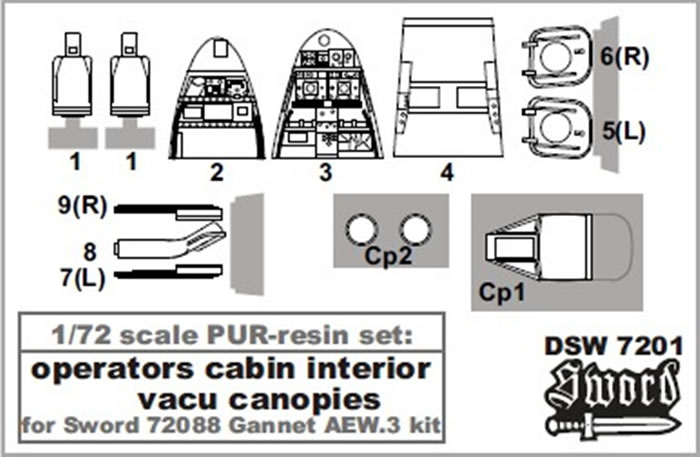|
Gannet AEW.3 Operators' Cabin Interior

Sword, 1/72 scale
S u m m a r y |
Catalogue Number: |
Sword Item No. DSW7201 – Gannet AEW.3 Operators' Cabin Interior |
Scale: |
1/72 |
Contents & Media: |
Ten resin and three clear vac-formed parts. |
Price: |
Available on-line from these stockists:
Click here for currency conversion. |
Review Type: |
First Look. |
Advantages: |
Good value detail set. |
Disadvantages: |
No seat harness detail or colour call-outs. |
Conclusions: |
Recommended to those who want that bit extra detail for a very fair price and just a little extra effort. |
Reviewed by Mark Davies

Eduard's 1/72 Avia B.534 IV serie Weekend Edition is available online from Squadron.com
The Gannet was designed to meet a requirement for a dedicated ship-borne Anti-Submarine Warfare (ASW) aircraft. The need was to combine both hunter and killer roles in one airframe, and retain a secondary anti-shipping strike capability. A notable feature of the design was the use of an Armstrong Siddeley Double Mamba turboprop engine. Two joined engines driving contra-rotating propellers provided for a compact streamlined installation, eliminated undesirable torque effects on take-off and landing, made for easy single engine handling, and allowed one engine to be shut down for economic cruise and loitering.
The US Navy realised the benefits of Airborne Early Warning (AEW) radar towards the end of WW2. AEW offered obvious advantages to seaborne air power. The Royal Navy first used US AEW radar carried by Douglas AD-4W Skyraiders. It was decided that a British AEW aircraft should be developed for the Royal Navy, and the Gannet was deemed the most suitable for development. The intention was to carry the same AN/APS-20 S-band (later re-designated E-band) radar as the Skyraiders.

The ASW Gannet fuselage was not suitable for the AEW role, especially as side-by-side seating of the radar operators was required. Consequently, a new fuselage was designed. A significantly more powerful version of eh Double Mamba was used, and exhausted just below the wing’s leading edge rather than just above the trailing edge as on other Gannets. The undercarriage was also lengthened to provide clearance for the radome on landing, along with a different fin shape.
The AEW Gannet was to disappear with the Royal Navy’s aircraft carriers, but the same radar was to soldier on under the noses of Avro Shackeltons until the introduction of the RAF’s Boeing E-3 Sentry.
A couple of worthwhile You Tube videos of Fairey Gannet AEW.3, XL502 taxiing and in flight can be viewed by clicking here and here.
This detail set is designed to complement the rather nice Sword Gannet AEW.3 kit that I reviewed here on HyperScale in July last year. The kit features quite comprehensive detail in the pilot’s cockpit using a combination of injected styrene and PE parts. However, the radar operators’ position is bare since nothing is visible through the two small bulged portholes.
The detail set comes in a small end-opening box with the parts map and assembly drawings pasted to its sides.
Box.jpg
The resin and vac-formed clear parts come in two zip-lock plastic bags separating the different media.

The instructions are simple and effective enough:

The parts are nicely produced and should be easy enough to remove from their casting blocks and assemble. It will be necessary to remove one, or preferably both, access hatches to the radar operators’ compartment in order to have much of a chance of seeing the detail the set provides. Replacement resin hatches with clear vac-formed bulged portholes obviously replace the cut out kit items.
All is well and good so far then. It may not matter a great deal, as not much will be visible, but the radar ops’ seats lack any harness detail. I should think that two forward-facing personnel would require both lap and shoulder harnesses to cope with arrested carrier landings, aside from being restrained to cope with in-flight turbulence.
Another slight negative is that Sword gives no colour call-outs. Sword must have researched the radar ops’ compartment to produce this set, so it seems that the least they could do is supply some detail painting advice. This could be via the instructions (if these were larger and folded inside the box), or by using photo images on Sword’s website.
The set also includes a replacement vac-form canopy for the pilot’s cockpit, which will offer a better chance to see the quite god kit detail through, or it can be sectioned and posed open.

This is a good quality detail set and is attractively priced. It is quite easy to install and will enhance the kit in the eyes of those that like crew areas to be detailed.
I feel the radar ops’ seats should have included harness detail cast integrally, and that Sword really should have made a presumably small effort to provide colour call-outs.
Even with both access hatches opened, I doubt that there will be very much detail visible without very close perusal; but often such is the way with cockpit detail in “The One True Scale”.
Recommended to those who want that bit extra detail for a very fair price and just a little extra effort.
Thanks to Sword Models for the review sample.
Review Text Copyright © 2016 by Mark Davies
Page Created 4 October, 2016
Last updated
5 October, 2016
Back to HyperScale Main Page
Back to Reviews Page |
